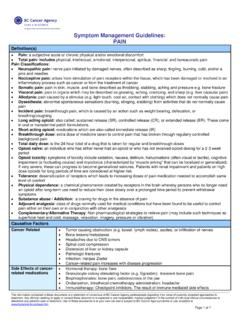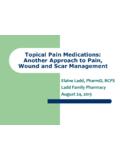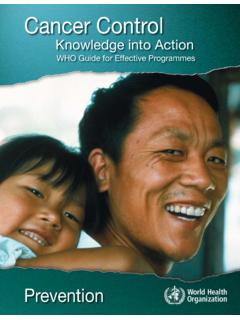Transcription of GET THE FACTS ABOUT GYNECOLOGIC CANCER
1 CERVICAL | OVARIAN | UTERINE | VAGINAL | VULVARGet the FACTS ABOUT GYNECOLOGIC CancerGET THE FACTS ABOUT GYNECOLOGIC CANCERGet the FACTS ABOUT GYNECOLOGIC CancerABOUT THIS BOOKLET This booklet was developed in support of the Centers for Disease Control and Prevention s (CDC) Inside Knowledge: Get the FACTS ABOUT GYNECOLOGIC CANCER campaign. The campaign helps women get the FACTS ABOUT GYNECOLOGIC CANCER by providing important inside knowledge ABOUT their bodies and health. As you read this booklet, you will learn ABOUT the different types of GYNECOLOGIC CANCER . These are cancers that affect the female reproductive organs. They include cervical, ovarian, uterine, vaginal, and vulvar cancers. You will find information on: Signs, symptoms, and risk factors related to each GYNECOLOGIC CANCER . What you can do to help prevent GYNECOLOGIC CANCER . What to do if you have symptoms.
2 What to do if you think you may be at increased risk for developing a GYNECOLOGIC CANCER . Questions to ask your year, ABOUT 89,000 women in the United States are diagnosed with a GYNECOLOGIC CANCER . While all women are at risk for developing GYNECOLOGIC cancers, few will ever develop one. Still, it is important to know the signs because there is no way to know for sure who will get a GYNECOLOGIC CANCER . The information included in this booklet will help you recognize warning signs so you can ask your health care provider ABOUT them. These signs and symptoms often are related to something other than GYNECOLOGIC CANCER . But it is important for your overall health to know what is causing words to know appear in italics and are defined in the glossary at the back of the booklet. The Inside Knowledge: Get the FACTS ABOUT GYNECOLOGIC CANCER campaign is an initiative that supports the GYNECOLOGIC CANCER Education and Awareness Act of 2005, or Johanna s Law, which was unanimously passed by the 109th Congress in 2006, and signed into law in January 2007.
3 TO FIND OUT MORE: Visit or call 1-800-CDC-INFOGet the FACTS ABOUT GYNECOLOGIC CancerWHAT IS CANCER ? CANCER is a group of diseases in which abnormal cells in the body divide and grow out of control. These abnormal cells can spread to other parts of the body. When this happens, it is called metastasis. There are more than 100 different types of CANCER . CANCER is usually named for the organ or part of the body where it starts, or the type of cell in which it starts, even if it spreads to other body parts later. For example, CANCER that begins in the ovaries and spreads to another organ is still called ovarian CANCER , even after it has spread. WHAT CAUSES CANCER ? In most cases, the exact cause of CANCER is not known. However, it is clear that certain changes in cells can cause CANCER . These cell changes can be either acquired or inherited. If they are acquired, they are caused by environmental factors and things people do, such as smoking.
4 When cell changes are inherited, it means they are passed from parent to child through genes. 1 TABLE OF CONTENTS3 GYNECOLOGIC CANCER overview5 GYNECOLOGIC CANCER symptoms6 Questions to ask your doctor7 Cervical cancer10 Ovarian cancer14 Uterine cancer16 Vaginal cancer18 Vulvar cancer19 GYNECOLOGIC CANCER diagnosis20 Glossary 21 ResourcesWhat is GYNECOLOGIC CANCER ? GYNECOLOGIC CANCER is any CANCER that starts in a woman s reproductive organs. While they are often discussed as a group, each GYNECOLOGIC CANCER is unique. Each has different signs, symptoms, and risk factors (things that may increase your chance of getting CANCER ). For some of these cancers, there are ways to lower your five main types of GYNECOLOGIC CANCER are: Cervical CANCER : Begins in the cervix, the lower part of the uterus (or womb). Ovarian CANCER : Begins in the ovaries, located on each side of the uterus. Uterine CANCER : Begins in the uterus, the pear-shaped organ in a woman s pelvis where the baby grows when a woman is pregnant.
5 Vaginal CANCER : Begins in the vagina, the hollow, tube-like channel between the bottom of the uterus and the outside of the body. It is also called the birth canal. Vulvar CANCER : Begins in the vulva, the outer part of the female genital organs, which includes the inner and outer lips of the vagina, the clitoris, and the opening of the vagina and its glands. Additional types of GYNECOLOGIC CANCER exist, and include fallopian tube CANCER and primary peritoneal CANCER . (Please see p. 12 for more information.) Who gets GYNECOLOGIC CANCER ?While all women are at risk for GYNECOLOGIC CANCER , this risk generally increases with age. Every year in the United States, ABOUT 89,000 women are diagnosed with and more than 29,000 die from a GYNECOLOGIC CANCER . GYNECOLOGIC CANCER OVERVIEWF allopian TubeOvaryUterusCervixVaginaVulva PAP TESTThe Pap test can find precancerous changes on the cervix that can be treated to prevent cervical CANCER .
6 A Pap test also can find cervical CANCER early, when treatment is most effective. Women should start getting regular Pap tests at age Pap test does NOT screen for ovarian, uterine, vaginal, or vulvar cancers. Even if you have a Pap test regularly, see your doctor if you notice any signs or symptoms that are not normal for you. HPV TESTA lmost all cervical cancers and some vaginal and vulvar cancers are caused by the human papillomavirus, or HPV. The HPV test looks for HPV infection. This test may be used with the Pap test to screen for cervical CANCER in women aged 30 years and older. It also is used to provide more information when a Pap test has unclear results. If you have HPV, follow your doctor s advice for further testing. (For more information ABOUT both the Pap test and HPV test, see pgs. 8-9)What increases a woman s risk of getting GYNECOLOGIC CANCER ?There is no way to know which women will get GYNECOLOGIC CANCER .
7 Each type of GYNECOLOGIC CANCER has unique risk factors. These are discussed in detail for each CANCER on the pages that infections that do not go away increase the risk of getting several types of GYNECOLOGIC CANCER . HPV is a common sexually transmitted virus that can cause cervical, vaginal, and vulvar cancers. It is one of the most well-established risk factors for these three more information ABOUT your risk, talk to your doctor, nurse, or other health care professional.** Please note that throughout the brochure the word doctor will be used to refer to doctors, nurses, and other health care gets HPV?HPV is a common virus with more than 100 different kinds or types. More than 30 of the types can be passed from one person to another during sex. HPV can occur in both men and women. HPV is so common that most people get it at some time in their woman who has ever had sex is at risk for getting HPV.
8 Women are more likely to have HPV if they started having sex at an early age and if they or their partner have had sex with several others. Condoms can lower your chance of getting HPV, if they are used all the time and the right way. However, HPV can infect areas that are not covered by a condom, so condoms do not fully protect against does HPV cause CANCER ?Most of the time, people who become infected with HPV will not have any symptoms and the infection will clear up on its own. However, when the infection does not clear up, it can cause normal cells to turn abnormal. Over time, these abnormal cells can turn into CANCER of the cervix, vagina, or likely am I to get a GYNECOLOGIC CANCER if I have HPV?Many people will have an HPV infection at some time in their lives, but few women will get cervical, vaginal, or vulvar CANCER the GYNECOLOGIC cancers that are linked to can I help prevent GYNECOLOGIC CANCER or find it early?
9 While there is no known way to prevent all types of GYNECOLOGIC CANCER , there are things you can do that may help lower your chance of getting them or help to find them early. It is important to find GYNECOLOGIC cancers early, when treatment can be most effective. Pay attention to your body and know what is normal for you. If you have any abnormal vaginal bleeding, or if you have any other signs and symptoms of GYNECOLOGIC CANCER for two weeks or longer and they are not normal for you, talk to a doctor right away. Make healthy lifestyle choices. For overall good health, eat a diet rich in fruits and vegetables; exercise regularly; maintain a healthy weight; avoid smoking; and practice safe sex. Know your family health history. Share it with your doctor. Get the HPV vaccine if you are at an age when it is recommended. It protects against the types of HPV that most often cause cervical, vaginal, and vulvar cancers.
10 It is recommended for preteens (both boys and girls) aged 11 to 12 years, but can be given as early as age 9 and until age 26. The vaccine is given in a series of either two or three shots, depending on age. If vaccination starts before age 15, a 2-dose schedule is recommended, with the 2 doses given 6 12 months apart. For teens and young adults who start the series at age 15 through 26, the vaccine is given in a series of three shots (0, 1-2, and 6 months). To learn more ABOUT the HPV vaccine visit Get regular Pap tests. Pap tests (or Pap smears) are one of the most reliable and effective CANCER screening tests available. Pap tests can find precancerous changes on the cervix that can be treated so that cervical CANCER is prevented. A Pap test can also find cervical CANCER early, when treatment is most effective. The only CANCER the Pap test screens for is cervical CANCER . Get the HPV test if it is recommended by your doctor.
















